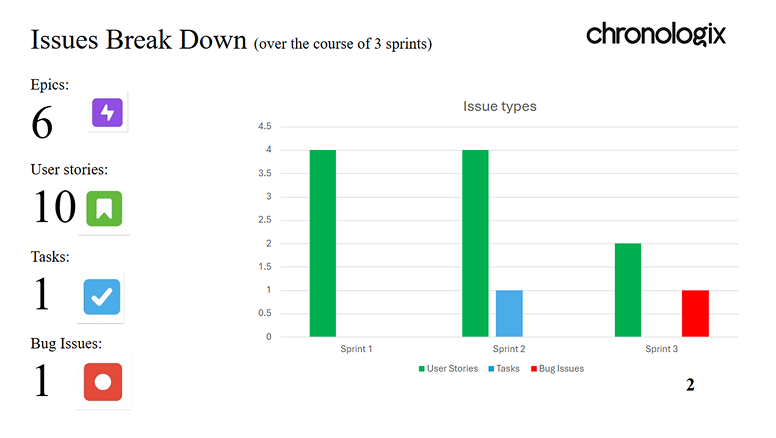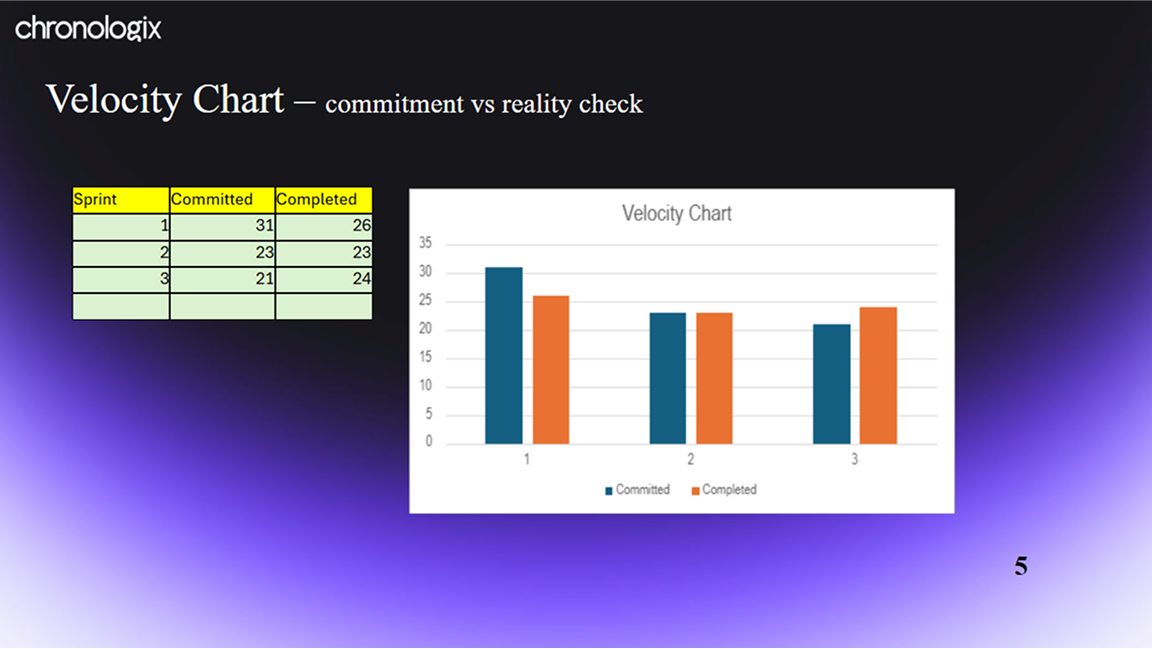Helping 30+ Students Stay Within Work Limits
April, 2025
A capstone project built with my team at Lambton College using Scrum, Chronologix helps international students track work hours with ease. See how we combined agile methods, Next.js, and MongoDB to create a practical solution.



Not sticking to your usual boring roles.
You can count me in two roles for Chronologix: Scrum Master and Product Designer. On the record, I facilitated sprint planning, retrospectives, and daily stand-ups—keeping our team aligned and energized. Behind the scenes, I pushed the team to their limits, inspiring everyone to give their best and meet tight deadlines. At the same time, I led the end-to-end design process—from user research with fellow international students to crafting interactive Figma prototypes that directly guided our Next.js development, helping us create meaningful impact.
"Jack of all trades, master of none, but oftentimes better than master of one."
— Anonymous / Proverb

Addressing the unseen challenges every Int'l student feels.

Challenge
International students often struggle to accurately track their work hours, which can lead to compliance issues and lost income. As a result, many unintentionally exceed the legal working limits set by the country.
Solution
To overcome the fear of exceeding permitted work hours, the app helps international students track their time accurately—ensuring they stay compliant, avoid penalties, and maintain peace of mind while reaching their ultimate goal, that is to study.
From Assumptions to Insights: Where Ideas Begin
Before we started sketching, it was important for us to first explore and understand the true need for the product. A crucial part of this process was speaking directly with actual users—including ourselves—to ensure we prioritized their needs rather than just our own assumptions.
But first, lets just assume...
What might be the reasons students aren’t fully aligned with the study-work rules? Based on this, we developed the following hypotheses:

Conclusion
Our analysis showed that economic pressure (score: 9) is a key reason students overwork—they often need the income to cover living and tuition costs.
At the same time, lack of proper monitoring (score: 6) means there’s no consistent system to track or enforce work limits, especially for students.
Actions over procrastination
As the product lead, I needed to put our hypotheses to the test and identify which assumptions held true and which didn't. To do this, I conducted a general survey targeting international students who met the following criteria:

After each participants were handed out the link to take the survey, a total of 13 participants from 4 origin countries successfully took the survey, each showcasing their individual hurdles while working as well as studying abroad.

Results?
- 53.8% of participants reported that they typically keep track of their work hours only in memory.
- Spreadsheets were the most common method used for recording work hours among participants, making exporting an essential component.
- The majority of respondents were pursuing postgraduate studies.
- 76.9% of participants indicated they would value alerts when approaching their legal work-hour limit.
User Stories, Jira & Flows: Where it all began
By taking the notes of the survey, we started brainstorming and forming scenarios and user stories of how we might actually help int’l students keep track of their working hours. We made list of 5 different epics, each containing the issues - user stories, tasks and bugs.

Of course, we couldn't work on all pieces at once, so we simultaneously gave Scrum estimation of story points by attending a planning poker session, so that each issue is addressed in terms of complexity, effort, and time required for implementation. This helped us prioritize tasks effectively and ensure realistic sprint planning based on team capacity.

At the end of the day...
We made use of the most obvious tool for managing Scrum — Jira. It allowed us to seamlessly create, estimate, and organize our user stories. Finally, after rigorous planning and countless iterations, our backlog for the sprint looked something like this:

And this was our timeline
(Note: the screenshot below was taken at the end of the project)

And our workflow looked something like this


Time was to start getting my magical hands into its work
Well, that sounded cliche but yeah, it was actually time to change my product designer hat and put on the LOFI music on youtube and get to work.
In this sprint, we already sat down and got the scopes and requirements ready. So there was no point in wasting time drawing numerous pointless user flows and wireframes, because the solution was pretty basic. As basic as:

I had to move quick, the devs were...
They were getting paid for doing nothing — well, that might be a bit dramatic, considering it was a capstone project and no one was actually getting paid. But still, if this had been an organization-run project, it would’ve been a financial sinkhole. Wasted time, unclear roles, and lack of coordination meant that in a real-world setting, we’d essentially be bleeding money without delivering value.
I handed them the basic concept of the user flow and provided the information architecture of how I wanted things to line up so that they could get things ready and can just change the interface later on. Normally the design thinking process is to be executed at least a sprint ahead of the development, but this is real-life scenario and things are not perfect.
I started with some basic designs
The concept was simple - straight to point
I needed to design something that worked seamlessly on both desktop and mobile, so users could access their records anytime, anywhere.
However, the devs were in their own LALA LAND ...

But they just had to get everything in the place, so that later they could easily just change the interface and everyone live happily ever after.
But at the end of the sprint, it all worked out
Adding work hour records
We added MUI library since it helped us deliver the best experience while picking the right date and time and also sorted the records according to the weeks so that users can track the hours weekly basis.
The ease of a clock interface helped users pick the right time without any hassle due to its familiar design, reduced typing effort, and clear visual feedback.
By showcasing only the recent week, users were able to focus on their most relevant and current logs, reducing cognitive load and making the interface feel less overwhelming.
Responsive & Adaptive
While we focused more on the mobile first approach, we made sure the transition to desktop was seamless, everything had to fall in place without sacrificing any great experience.
Ensured the mobile version followed best accessibility practices so it felt truly mobile-first, not just a desktop app squeezed into a smaller screen.
Every animation had to communicate and behave smoothly, better animation → better experience
Using MUI Design System Saved Us Big
Since our team was quite tight with the schedule, we had to move quick and what other option would there had been if not by using a ready-to-dev design system available for free.

Material UI file for figma had been a game changer for me, from easy variables changes to quick tokens theme export, I couldn't ask anything more.

Then bringing those theme tokens to code was smooth as butter.
Back to the backlog and timeline ...
After pulling off such an amazing sprint, we went back to the drawing board and Jira. Though we had the basics in place, the app was not yet ready to be handed to our early users and gain some valuable insights through gorilla testing. We still had to reach the release plan for the end of sprint 3 “Platform with records and employers fully configured”.


Now the things we had to make sure:
- Getting the Landing page somewhat accessible and pretty.
- Check for any bugs in the records.
- The app should be able to handle the data of multiple users and employers.
- Users be able to add their employer.
- Deploy our first ever release for availability of users.
And we did just that .... kinda
Adding an employer
To support custom duties for each work record, we introduced the ability to add employers. This allowed users to assign pay rates and later export logs based on specific employers.
With duties pre-assigned, users can easily select the employer when adding records, allowing them to focus more on entering date and time—streamlining the process and improving the overall experience.
Users can later export their logs filtered by employer, making it easy to share specific records with their manager.
And this was the landing page, nothing else to say.
There is nothing challenging in designing a landing page.

Testing the first release
After the first release, we wasted no time sharing the app with users. Almost immediately, new accounts started rolling in, along with a surge of work records being added. And no—we didn’t calculate how much each user was earning. We could have, but we didn’t. That’s integrity.
( Note: Each user received a disclaimer clearly stating that they were in full control of their data. We emphasized that we were not responsible for any data loss, as the product was still in its early development phase. It was also made clear that none of their information would be made public.)
Receiving mixed responses
3 out of 5 users were working two or more jobs at the same time, so the app made it easier for them to track how many hours they were dedicating to each job individually, as well as their total combined hours.
Users could see how the app helped keep track of their daily work routines and were highly positive regarding the usability of the application.
Out of 5 users tested, 2 reported issues with work logs not being aligned weekly. (e.g. If I had worked from 11:30 pm - 5 am) this entry counted as record for today.
30% of the users were using the application on a daily basis.
Back to design...
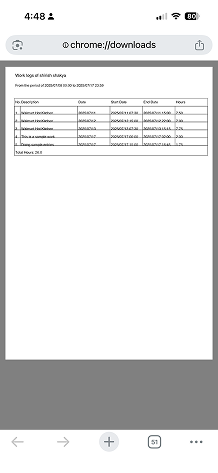
Being able to export the records
Exporting records was a key feature we had to get right. It was essential because many users work on tight budgets and need to track their earnings and expenses accurately.
Exporting as CSV let users easily track and calculate their hours and earnings.
Exporting as PDF lets users show managers their pay stubs if they spot any errors.
Managing settings
One of the key additions was the Settings feature, where users can personalize their experience by managing their country of study, currency, time zone, and work hour threshold.
Users can change the time zone if they switched country or by any means want to change the preferences
Users can update the currency if they change their country or if their pay currency changes, ensuring accurate tracking and reporting.
Users can also adjust the work hour threshold to stay compliant if regulations or rules change in their country of study. This ensures that the student always stay aware with the policy changes.
Dashboard
The dashboard was last on our backlog but a key part of the app. It helps users track their weekly work hours to prevent them from going overboard.
Making the final user tests.
After pushing the final commit, we crossed our fingers, hoping we nailed it. We had built what felt like the perfect companion for students—with wins like free log exports and seamless work hour tracking. But looking back, we knew we could’ve pushed further and not stopped there.
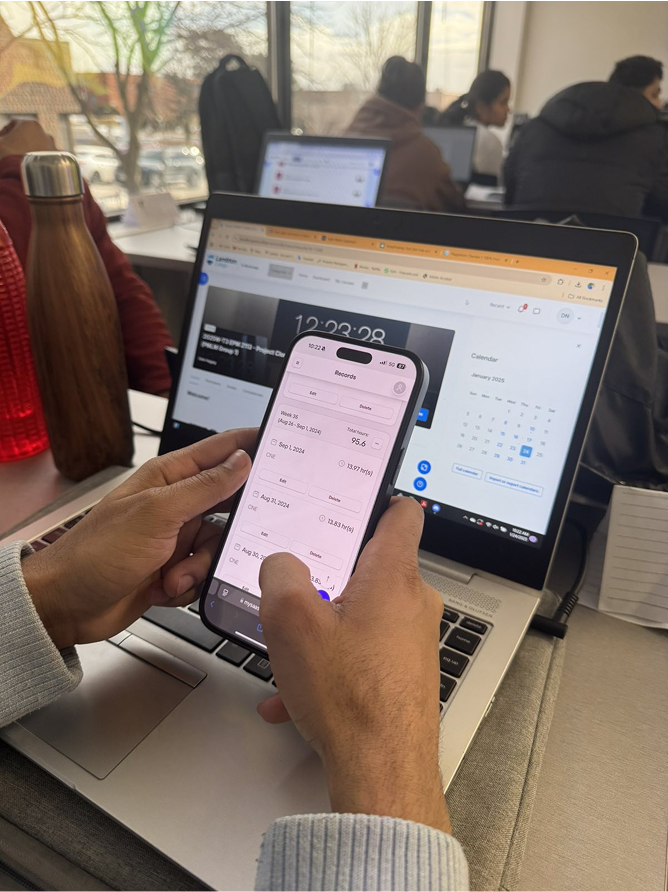
The final responses
Being able to export logs was a game changer—many students struggled with exporting on other platforms because of paywalls or purchase restrictions.
Users said they can now confidently add the work logs without any timing issues - which we fixed it in this sprint
70% of users said the app significantly improved their lives as an int’l student, especially in terms of portability and user experience.
Wrapping everything in a nutshell.
This journey of ours was truly an amazing experience filled with challenges.
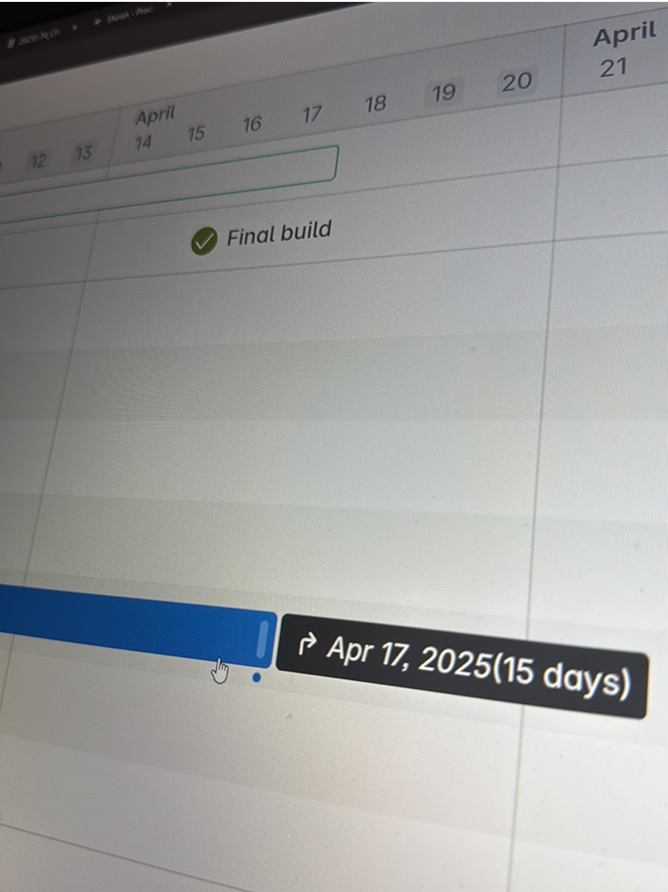
Things we won at
We stayed on track from planning to execution, checking every box along the way.
Continuous product development, backed by research and user testing, helped us validate our hypotheses and deliver what users truly needed.
We delivered an impactful product that users love and are still using for their daily routine
We documented everything and followed scrum to its deepest roots, making simultaneous scope changes and releases possible.
We were the best team for this capstone project from our class and received great grades (the whole point).
Things we coud’ve worked more on..
If we had worked more on alerting the users when they were at the end of the work hour threshold, we would’ve hit all the aces. But a task for another day maybe.
If we had generated more PR, the product might have reached entirely new heights.
